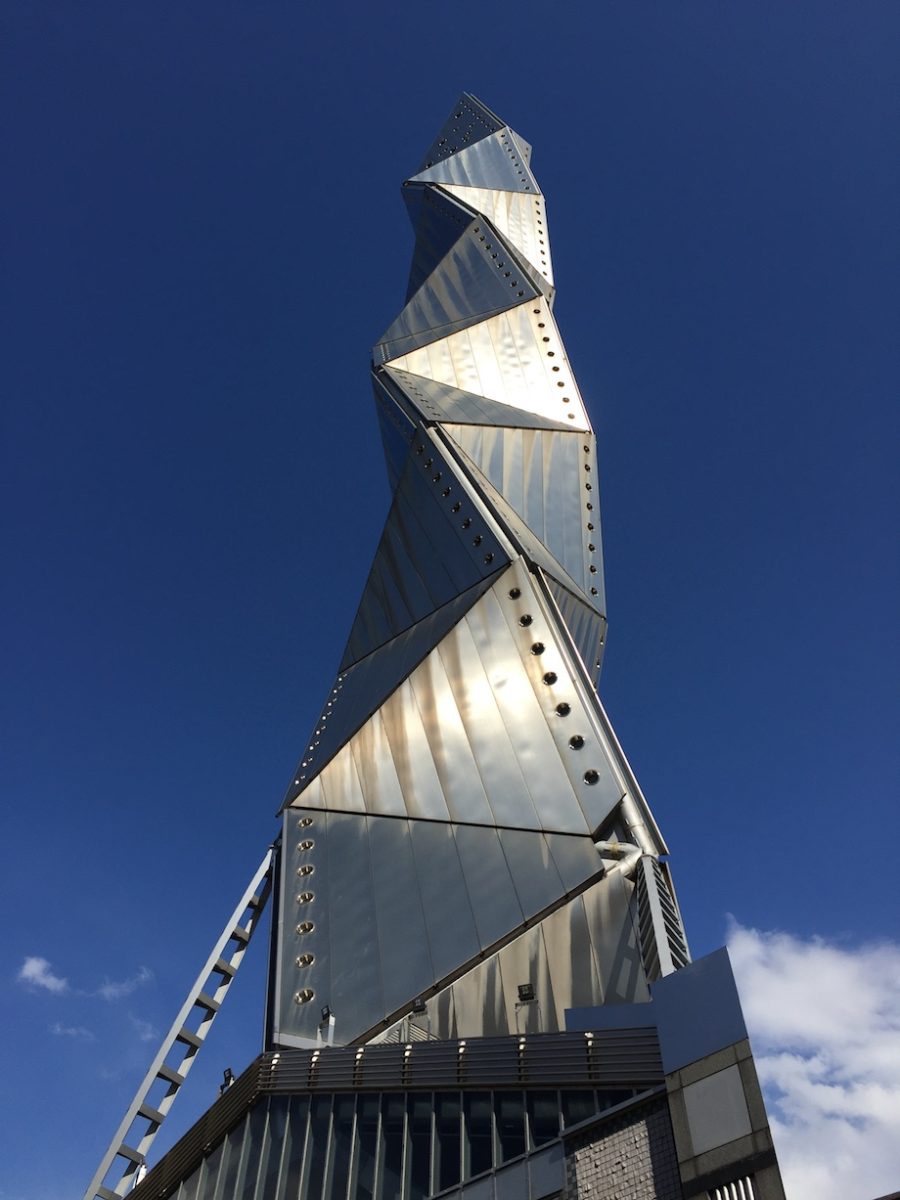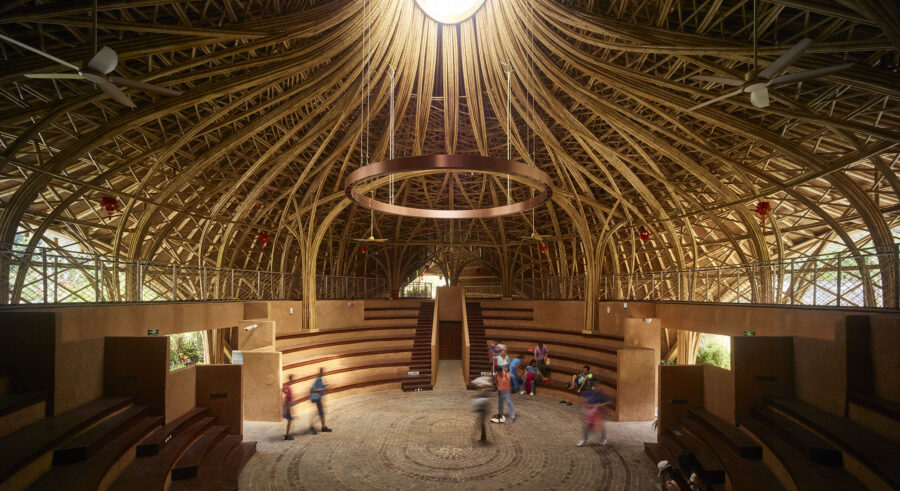
CULTURE


© MVRDV
MVRDVが作成した〈海面上昇カタログ(Sea Level Rise Catalogue)〉は、カナダの都市バンクーバーの中心部を流れるフォールス川周辺における、建築からランドスケープ、インフラにいたるまで、幅広い提案を納めたカタログです。新築だけでなく、既存の高層ビルを陸上と水上の交通をつなぐモビリティハブとして機能させるなど、改修によるアプローチも数多く含んでいます。
また各提案には、海面上昇への対応に加え、公平性、持続可能性、居住性を高める効果が期待できる「Win-Win」の要素が含まれていることも大きな特徴です。再生可能エネルギーの導入、住宅供給量の増加、公共スペースの追加、生物多様性の改善といった要素を含むことで、さまざまなステークホルダーから広く支持されるものとなっています。
(以下、MVRDVから提供されたプレスキットのテキストの抄訳)

In Between Bridges_Current situation © MVRDV

In Between Bridges_Year 2040 © MVRDV

In Between Bridges_Year 2100 © MVRDV
海面上昇に適応するためのさまざまな方策を納めたカタログ
水に逆らわず共存する、MVRDVが作成した〈海面上昇カタログ〉は、都市が気候変動にどのように適応できるかを示している。
MVRDVは、ノースクリーク・コレクティブ(North Creek Collective)というチームの一員として、バンクーバーとその中心部を流れるフォールス川の未来について探求するため、バンクーバー市が主催する「Sea2City デザインチャレンジ」に参加した。

Coopers’ Park_Current situation © MVRDV

Coopers’ Park_Year 2040 © MVRDV

Coopers’ Park_Year 2100 © MVRDV
〈海面上昇カタログ〉は、バンクーバー市が海面上昇に適応するため、ウォーターフロントにおける建物、ランドスケープ、インフラにいたるまで、幅広い提案を納めたカタログである。
これにより、世界中の沿岸都市が気候変動に適応するため、早急に行動を起こすよう促すことを目的としている。

© MVRDV
海面上昇へ対応する未来を示し、バンクーバーをグローバルリーダーへと導くプロジェクト
気候変動による海面上昇は、高潮、干ばつ、地盤沈下などを引き起こし、さまざまな都市を脅かす、世界的な課題となっている。
海面上昇への一般的な対策は、防潮堤や堤防を高くして水に対抗することである。しかしこのようなアプローチは、波や高潮を吸収する海岸の自然な能力を制限してしまい、洪水を悪化させてしまうこともある。もし、都市が水に逆らうのではなく、水と協力することを学んだとしたらどうだろう。

© MVRDV
バンクーバー市が主催する「Sea2City デザインチャレンジ」は、バンクーバーの主要なスポットが集まるフォールス川周辺の未来について探求するチームを募集したものであり、〈海面上昇カタログ〉はこのデザインチャレンジへの応募作品を補足するものである。
このカタログは、将来のバンクーバーをより弾力的で包括的な都市とするために貢献する。

© MVRDV
MVRDVの設立パートナーであるナタリー・デ・フリース(Nathalie de Vries)は次のように語る。
「フォールス川におけるこの先100年の開発に取り組むにあたり私たちは、すでにそこにある建物の種類から、この場所を大切にするマスケアン、スコーミッシュ、ツレイル・ウォートゥスといったまちや先住民のコミュニティにいたるまで、バンクーバーの文脈を注意深く考察した。」
「この〈海面上昇カタログ〉により、世界中の都市に影響を与える海面上昇へ適応する未来を示すことで、バンクーバーは他の都市に未来への道を示すグローバルリーダーとなることができるのである。」

© MVRDV
既存の建物から新築、インフラにいたるまで、さまざまな可能性を示すカタログ
〈海面上昇カタログ〉は、海面上昇を考慮した既存の建物や地域の改修、新しい建築物の開発のためのさまざまな例を提供している。
例えば、垂直方向に拡張してコミュニティテラスを設けることでタウンハウスを洪水に適応させ、中層ビルを構造体のフレームに戻すことで柔軟な公共プログラムに対応させ、高層ビルを陸上と水上の交通をつなぐモビリティハブとして機能させるなど、さまざまな例が掲載されている。
他にも、浮遊するさまざまな生物の生息地、適応性のある住宅やオフィス、スポーツ施設、文化スペース、高床式の複合高層ビルや小さな居住区、潮流に応じて上下する水陸両用レストラン、浸透性の地被類や雨水緩衝材を組み込むことで都市の洪水に対する回復力を強化する内陸開発、などがある。

© MVRDV
このカタログでは、既存の建造物を改修する場合も、新しい建造物を建設する場合も、都市が新しい設計において考慮すべき6つの基本原則を概説している。地下構造物の洪水対策としての新しい利用法から、高架歩道の開発まで、これらの原則は、建物やインフラが水と共存できるように設計されている。
また各提案には、海面上昇への対応に加え、公平性、持続可能性、居住性を高める効果が期待できる「Win-Win」の要素が含まれていることも大きな特徴である。再生可能エネルギーの導入、住宅供給量の増加、公共スペースの追加、生物多様性の改善など、各提案は水との関係性に加えて、さまざまなステークホルダーから広く支持されるための要素を提供している。

© MVRDV
ノースクリーク・コレクティブがフォールス川のために作成した長期ビジョンと〈海面上昇カタログ〉を組み合わせることで、バンクーバーの水辺との関係を再構築するだけでなく、世界中の沿岸都市に、適応性と弾力性を備えた持続可能な未来へ向かう方法を示すことができるだろう。
MVRDVが、PWLパートナーシップ・ランドスケープ・アーキテクツ(PWL Partnership Landscape Architects)、Deltares、モダン・フォームライン・デザイン(Modern Formline Design)を含むチームの一員として作成した〈海面上昇カタログ〉は、WestMar Advisors、G.L. Williams & Associates、Happy City、Modus, Goudappelからのサポートにより実現したものである。

© MVRDV

© MVRDV

© MVRDV

© MVRDV
以下、MVRDVのリリース(英文)です。
Working with water, not against it: MVRDV’s “Sea Level Rise Catalogue” shows how cities can adapt to climate change
MVRDV, as part of a team named North Creek Collective, has presented a series of proposals for the City of Vancouver, to adapt waterfront buildings, landscape and infrastructure to accommodate to rising sea levels. The collective responded to the Sea2City Design Challenge meant to investigate the urban future of False Creek, a body of water in the heart of Vancouver. The project resulted in an extensive catalogue of options for adaptive buildings. With it, the makers aim to inspire other coastal cities around the world to undertake immediate action to adapt to climate change.
Sea level rise is a global challenge. Many thriving cities are located on the waterside, and so a climate-change-induced rise in sea level, combined with increases in storm surges, droughts, and land subsidence, threatens cities globally. Typical responses to these challenges have been to resist the water with higher flood barriers and dikes. However, such approaches often worsen flooding in cities, limiting the natural ability of the foreshore to absorb wave energy, storm surge and run-off. What if cities learned to work with water, rather than against it?
As part of a team named the North Creek Collective, MVRDV has made a catalogue of possible solutions for adapting waterfront buildings and infrastructure to accommodate and absorb encroaching water. This Sea Level Rise Catalogue supplements their entry to the City of Vancouver’s Sea2City Design Challenge, which invited teams to investigate the urban future of False Creek, a body of water in the heart of Vancouver that is home to a number of the city’s major attractions. The proposals of this catalogue contribute to making Vancouver a more resilient and inclusive city in the future.
“In tackling the next century of False Creek’s development, we looked closely at the context of Vancouver – considering everything from the types of building already found there, to the community values of the city and local First Nations, such as Musqueam, Squamish, and Tsleil- Waututh, for whom this is an important site”, says MVRDV founding partner Nathalie de Vries. “With our approach, we offer ideas that can also be adapted to new contexts elsewhere; with the Sea Level Rise Catalogue, Vancouver can become a global leader, showing other cities a way into the future. Sea level rise is a challenge that will impact cities globally, from Miami to Manila.”
The Sea Level Rise Catalogue offers examples for both adapting existing buildings and areas, developing new structures with sea level rise in mind. It includes vertical extensions of flood-adaptive townhouses with community terraces, mid-rises stripped back to their structural skeletons to accommodate flexible public programmes, and high-rises serving as mobility hubs to connect land- and water-based transport. Ideas for new constructions include floating habitat islands, adaptive houses, offices, sports facilities, and cultural spaces; mixed-use high-rises and small neighbourhoods on stilts; an amphibious restaurant that rises and falls in response to the tide; and inland developments that bolster the city’s flood resilience by incorporating permeable ground coverings, community spaces, and rainwater buffers.
The catalogue outlines six fundamental principles that cities should consider in new designs, both when adapting existing structures and constructing new ones. From finding new, flood-proof uses for underground structures, to the development of raised walkways, these principles are designed to ensure that buildings and infrastructure can coexist with water – whether that involves accommodating higher tides on a daily basis, or being prepared for more frequent storm surges.
Crucially, each idea is accompanied by an explanation of potential “win-wins”: positive impacts the design can offer that make the city more equitable, sustainable, and liveable, in addition to their ability to address sea level rise. From incorporating renewable energy sources, to increasing housing provision, and from adding public spaces to improving biodiversity, each proposal offers something in addition to its relationship to the water that can help to ensure widespread support among various stakeholders. When combined, the long-term visions created by the North Creek Collective for False Creek and the Sea Level Rise Catalogue could serve not only to reimagine Vancouver’s relationship to its waterfront, but also to provide a guiding light to coastal cities all over the world, showing how to move towards an adaptive, resilient, sustainable future.
MVRDV developed the Sea Level Rise Catalogue as part of team MVRDV + PWL, which also included PWL Partnership Landscape Architects, Deltares, and Modern Formline Design, with support from WestMar Advisors, G.L. Williams & Associates, Happy City, Modus, and Goudappel.
Credits
Location: Vancouver, Canada Client: City of Vancouver Year: 2022
Programme: Urban vision
Architect: MVRDV
Principal in charge: Nathalie de Vries Partner: Enno Zuidema
Design team: Kristina Knauf, Stijn Lanters, Başak Günalp, Antonio Luca Coco, Stefania Trozzi, Angelo La DelfaVisualization
Images: MVRDVCopyright: MVRDV – (Winy Maas, Jacob van Rijs, Nathalie de Vries)
Partners
Contractor: City of Vancouver
Landscape engineer: PWL Partnership Landscape Architects Inc., Vancouver, Canada
Environmental advisor: Deltares, Delft, Netherlands
Cultural advisor: Modern Formline Design, Vancouver, Canada
Advisory groups: Westmar Advisors, Modus, Goudappel, The Happy City
「SEA2CITY VANCOUVER」MVRDV 公式サイト
https://www.mvrdv.nl/projects/828/sea2city-vancouver









